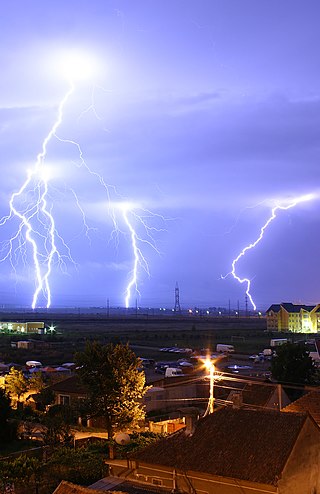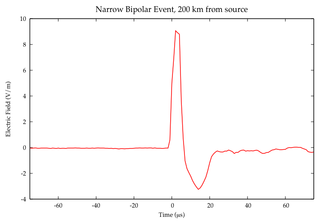Related Research Articles

Cosmic rays or astroparticles are high-energy particles or clusters of particles that move through space at nearly the speed of light. They originate from the Sun, from outside of the Solar System in our own galaxy, and from distant galaxies. Upon impact with Earth's atmosphere, cosmic rays produce showers of secondary particles, some of which reach the surface, although the bulk are deflected off into space by the magnetosphere or the heliosphere.

Lightning is a natural phenomenon formed by electrostatic discharges through the atmosphere between two electrically charged regions, either both in the atmosphere or with one in the atmosphere and on the ground, temporarily neutralizing these in a near-instantaneous release of an average of one gigajoule of energy. This discharge may produce a wide range of electromagnetic radiation, from heat created by the rapid movement of electrons, to brilliant flashes of visible light in the form of black-body radiation. Lightning causes thunder, a sound from the shock wave which develops as gases in the vicinity of the discharge experience a sudden increase in pressure. Lightning occurs commonly during thunderstorms as well as other types of energetic weather systems, but volcanic lightning can also occur during volcanic eruptions. Lightning is an atmospheric electrical phenomenon and contributes to the global atmospheric electrical circuit.
Ionizing radiation, including nuclear radiation, consists of subatomic particles or electromagnetic waves that have sufficient energy to ionize atoms or molecules by detaching electrons from them. Some particles can travel up to 99% of the speed of light, and the electromagnetic waves are on the high-energy portion of the electromagnetic spectrum.

A spark gap consists of an arrangement of two conducting electrodes separated by a gap usually filled with a gas such as air, designed to allow an electric spark to pass between the conductors. When the potential difference between the conductors exceeds the breakdown voltage of the gas within the gap, a spark forms, ionizing the gas and drastically reducing its electrical resistance. An electric current then flows until the path of ionized gas is broken or the current reduces below a minimum value called the "holding current". This usually happens when the voltage drops, but in some cases occurs when the heated gas rises, stretching out and then breaking the filament of ionized gas. Usually, the action of ionizing the gas is violent and disruptive, often leading to sound, light, and heat.

A corona discharge is an electrical discharge caused by the ionization of a fluid such as air surrounding a conductor carrying a high voltage. It represents a local region where the air has undergone electrical breakdown and become conductive, allowing charge to continuously leak off the conductor into the air. A corona discharge occurs at locations where the strength of the electric field around a conductor exceeds the dielectric strength of the air. It is often seen as a bluish glow in the air adjacent to pointed metal conductors carrying high voltages, and emits light by the same mechanism as a gas discharge lamp. Corona discharges can also happen in weather, such as thunderstorms, where objects like ship masts or airplane wings have a charge significantly different from the air around them.

A Lichtenberg figure, or Lichtenberg dust figure, is a branching electric discharge that sometimes appears on the surface or in the interior of insulating materials. Lichtenberg figures are often associated with the progressive deterioration of high voltage components and equipment. The study of planar Lichtenberg figures along insulating surfaces and 3D electrical trees within insulating materials often provides engineers with valuable insights for improving the long-term reliability of high-voltage equipment. Lichtenberg figures are now known to occur on or within solids, liquids, and gases during electrical breakdown.

Paschen's law is an equation that gives the breakdown voltage, that is, the voltage necessary to start a discharge or electric arc, between two electrodes in a gas as a function of pressure and gap length. It is named after Friedrich Paschen who discovered it empirically in 1889.

In electronics, electrical breakdown or dielectric breakdown is a process that occurs when an electrically insulating material, subjected to a high enough voltage, suddenly becomes a conductor and current flows through it. All insulating materials undergo breakdown when the electric field caused by an applied voltage exceeds the material's dielectric strength. The voltage at which a given insulating object becomes conductive is called its breakdown voltage and, in addition to its dielectric strength, depends on its size and shape, and the location on the object at which the voltage is applied. Under sufficient voltage, electrical breakdown can occur within solids, liquids, or gases. However, the specific breakdown mechanisms are different for each kind of dielectric medium.
Elastic scattering is a form of particle scattering in scattering theory, nuclear physics and particle physics. In this process, the kinetic energy of a particle is conserved in the center-of-mass frame, but its direction of propagation is modified meaning the two particles in the collision do not lose energy. Furthermore, while the particle's kinetic energy in the center-of-mass frame is constant, its energy in the lab frame is not. Generally, elastic scattering describes a process in which the total kinetic energy of the system is conserved. During elastic scattering of high-energy subatomic particles, linear energy transfer (LET) takes place until the incident particle's energy and speed has been reduced to the same as its surroundings, at which point the particle is "stopped".

A terrestrial gamma-ray flash (TGF), also known as dark lightning, is a burst of gamma rays produced in Earth's atmosphere. TGFs have been recorded to last 0.2 to 3.5 milliseconds, and have energies of up to 20 million electronvolts. It is speculated that TGFs are caused by intense electric fields produced above or inside thunderstorms. Scientists have also detected energetic positrons and electrons produced by terrestrial gamma-ray flashes.

Atmospheric electricity describes the electrical charges in the Earth's atmosphere. The movement of charge between the Earth's surface, the atmosphere, and the ionosphere is known as the global atmospheric electrical circuit. Atmospheric electricity is an interdisciplinary topic with a long history, involving concepts from electrostatics, atmospheric physics, meteorology and Earth science.

Narrow bipolar pulses are high-energy, high-altitude, intra-cloud electrical discharges associated with thunderstorms. NBP are similar to other forms of lightning events such as return strokes and dart leaders, but produce an optical emission of at least an order of magnitude smaller. They typically occur in the 10–20 km altitude range and can emit a power on the order of a few hundred gigawatts. They produce far-field asymmetric bipolar electric field change signatures.
An electron avalanche is a process in which a number of free electrons in a transmission medium are subjected to strong acceleration by an electric field and subsequently collide with other atoms of the medium, thereby ionizing them. This releases additional electrons which accelerate and collide with further atoms, releasing more electrons—a chain reaction. In a gas, this causes the affected region to become an electrically conductive plasma.

In electromagnetism, the Townsend discharge or Townsend avalanche is a ionisation process for gases where free electrons are accelerated by an electric field, collide with gas molecules, and consequently free additional electrons. Those electrons are in turn accelerated and free additional electrons. The result is an avalanche multiplication that permits electrical conduction through the gas. The discharge requires a source of free electrons and a significant electric field; without both, the phenomenon does not occur.
The term runaway electrons (RE) is used to denote electrons that undergo free fall acceleration into the realm of relativistic particles. REs may be classified as thermal or relativistic. The study of runaway electrons is thought to be fundamental to our understanding of High-Energy Atmospheric Physics. They are also seen in tokamak fusion devices, where they can damage the reactors.

A gamma ray, also known as gamma radiation (symbol γ or ), is a penetrating form of electromagnetic radiation arising from the radioactive decay of atomic nuclei. It consists of the shortest wavelength electromagnetic waves, typically shorter than those of X-rays. With frequencies above 30 exahertz (3×1019 Hz), it imparts the highest photon energy. Paul Villard, a French chemist and physicist, discovered gamma radiation in 1900 while studying radiation emitted by radium. In 1903, Ernest Rutherford named this radiation gamma rays based on their relatively strong penetration of matter; in 1900 he had already named two less penetrating types of decay radiation (discovered by Henri Becquerel) alpha rays and beta rays in ascending order of penetrating power.
Electric discharge in gases occurs when electric current flows through a gaseous medium due to ionization of the gas. Depending on several factors, the discharge may radiate visible light. The properties of electric discharges in gases are studied in connection with design of lighting sources and in the design of high voltage electrical equipment.

A relativistic runaway electron avalanche (RREA) is an avalanche growth of a population of relativistic electrons driven through a material by an electric field. RREA has been hypothesized to be related to lightning initiation, terrestrial gamma-ray flashes, sprite lightning, and spark development. RREA is unique as it can occur at electric fields an order of magnitude lower than the dielectric strength of the material.

Joseph R. Dwyer is an American physicist known for his lightning research. He is a professor of physics at the University of New Hampshire. Dwyer received his Ph.D. in physics from the University of Chicago in 1994 and worked on cosmic-ray physics and gamma-ray astronomy as a research scientist at Columbia University and the University of Maryland before joining the faculty at the Florida Institute of Technology in 2000. After moving to Melbourne, Florida, Dwyer became interested in lightning physics and his research now focuses on high-energy radiation production from thunderstorms and lightning. In 2002, Dwyer and collaborators discovered that rocket-triggered lightning produced large quantities of x-rays, allowing for first the time detailed studies of an atmospheric phenomenon known as runaway breakdown. In 2014, Dwyer left the Florida Institute of Technology and joined the University of New Hampshire.

In electromagnetism, a streamer discharge, also known as filamentary discharge, is a type of transient electric discharge which forms at the surface of a conductive electrode carrying a high voltage in an insulating medium such as air. Streamers are luminous writhing branching sparks, plasma channels composed of ionized air molecules, which repeatedly strike out from the electrode into the air.
References
- ↑ A. V. Gurevich, G. M. Milikh, and R. A. Roussel-Dupre (1992) "Runaway electron mechanism of air breakdown and preconditioning during a thunderstorm," Physics Letters A, 165 : 463–468.
- ↑ Alexander V. Gurevich & Kirill P. Zybin (May 2005). "Runaway breakdown and the mysteries of lightning". Physics Today. 58 (5): 37–43. Bibcode:2005PhT....58e..37G. doi:10.1063/1.1995746.